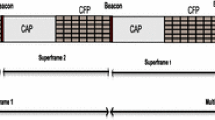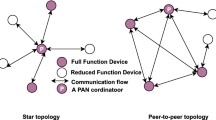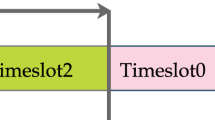Abstract
The IEEE 802.15.4 standard has been introduced for low latency and low energy consumption in wireless sensor networks. To better support the requirements of industrial applications, where the use of this standard is limited, the low latency deterministic network (LLDN) mechanism of the IEEE 802.15.4e amendment has been proposed. In this paper, we develop a three dimensional Markov chain model for the IEEE 802.15.4e LLDN mechanism. Then, we estimate the stationary probability distribution of this chain in order to derive theoretical expressions of some performance metrics, as the reliability, energy consumption, throughput, delay and jitter. After that, we conduct a comparative study between the IEEE 802.15.4e LLDN and the IEEE 802.15.4 slotted carrier sense multiple access with collision avoidance (CSMA/CA). Numerical results show that the deterministic behavior of the LLDN mechanism significantly reduces the collision probability providing best performances in terms of reliability, energy consumption, throughput and delay compared to the IEEE 802.15.4 slotted CSMA/CA. Finally, the accuracy of our theoretical analysis is validated by Monte Carlo simulations.
















Similar content being viewed by others
References
Chong, C. Y., & Kumar, S. P. (2003). Sensor networks: Evolution, opportunities, and challenges. Proceedings of the IEEE, 91(8), 1247–1256. doi:10.1109/JPROC.2003.814918.
Davenport, D. M., Ross, F. J., & Deb, B. (2009). Wireless propagation and coexistence of medical body sensor networks for ambulatory patient monitoring. In Sixth international workshop on wearable and implantable body sensor networks (pp. 41–45). doi:10.1109/BSN.2009.8.
Manes, G., Fantacci, R., Chiti, F., Ciabatti,M., Collodi, G., Di Palma, D., & Manes, A. (2007). Enhanced system design solutions for wireless sensor networks applied to distributed environmental monitoring. In IEEE 32nd conference on local computer networks (pp. 807–814). doi:10.1109/LCN.2007.151.
Miorandi, D., Uhlemann, E., Vitturi, S., & Willig, A. (2007). Guest editorial: special section on wireless technologies in factory and industrial automationpart I. IEEE Transactions on Industrial Informatics, 3(2), 95–98. doi:10.1109/TII.2007.898410.
Platt, G., Blyde, M., Curtin, S., & Ward, J. (2005). Distributed wireless sensor networks and industrial control systems: A new partnership. In The second IEEE workshop on embedded networked sensors EmNetS-II (pp. 157–158). doi:10.1109/EMNETS.2005.1469112.
IEEE Std. (2005). IEEE standard for information technology - telecommunications and information exchange between systems: Local and metropolitan area networks—Specific requirements. Part 15.1: Wireless medium access control (MAC) and physical layer (PHY) specifications for wireless personal area networks (WPANs).
IEEE. (1999). Part 11: Wireless LAN medium access control (MAC) and physical layer (PHY) specifications. IEEE Std, 802.11.
IEEE Std 802.15.4. (2011). IEEE standard for local and metropolitan area networks Part 15.4: Low-rate wireless personal area networks (LR-WPANs), (revision of IEEE std 802.15.4-2006).
IEEE Std 802.15.4. (2003). Wireless Medium Access Control (MAC) and Physical Layer (PHY) Specifications for Low Rate Wireless Personal Area Networks (WPANs).
IEEE Std 802:15:4TM. (2006). Revision of IEEE Std 802.15.4-2003.
IEEE Std 802:15:4aTM. (2007). Amendment to 802.15.4- 2006.
IEEE Std 802:15:4cTM. (2009). Amendment to IEEE Std 802.15.4-2006.
IEEE Std 802:15:4dTM. (2009). Amendment to IEEE Std 802.15.4-2006.
IEEE Std 802:15:4fTM. (2012). Amendment to IEEE Std 802.15.4-2011.
IEEE Std 802:15:4gTM. (2012). Amendment To IEEE Std 802.15.4-2011.
Viegas, R., Guedes, L. A., Vasques, F., Portugal, P., & Moraes, R. (2013). A new MAC scheme specifically suited for real-time industrial communication based on IEEE 802.11 e. Computers & Electrical Engineering, 39(6), 1684–1704. doi:10.1016/j.compeleceng.2012.10.008.
Seno, L., Vitturi, S., & Tramarin, F. (2012). Tuning of IEEE 802.11 MAC for improving real-time in industrial wireless networks. In IEEE 17th conference on emerging technologies and factory automation (ETFA) (pp. 1–8). doi:10.1109/ETFA.2012.6489553.
Vitturi, S., Seno, L., Tramarin, F., & Bertocco, M. (2013). On the rate adaptation techniques of IEEE 802.11 networks for industrial applications. IEEE Transactions on Industrial Informatics, 9(1), 198–208. doi:10.1109/TII.2012.2189223.
IEEE Std 802:15:4eTM (2012) (Amendment to IEEE Std 802.15.4-2011).
Jeong, W. C., & Lee, J. (2012). Performance evaluation of IEEE 802.15.4e DSME MAC protocol for wireless sensor networks. In First IEEE workshop on enabling technologies for smartphone and internet of things (ETSIoT) (pp. 7–12). IEEE. doi:10.1109/ETSIoT.2012.6311258.
De Guglielmo, D., Anastasi, G., & Seghetti, A. (2014). From IEEE 802.15.4 to IEEE 802.15.4e: A step towards the internet of things. In S. Gaglio & G. Lo Re (Eds.), Advances onto the internet of things (pp. 135–152). Switzerland: Springer International Publishing.
Berger, A., Entinger, A., Potsch, A., & Springer, A. (2014). Improving IEEE 802.15.4e LLDN performance by relaying and extension of combinatorial testing. In Emerging technology and factory automation (ETFA) (pp. 1–4). IEEE. doi:10.1109/ETFA.2014.7005328.
Lee, J., & Jeong, W. C. (2012). Performance analysis of IEEE 802.15.4e DSME MAC protocol under WLAN interference. In International conference on ICT convergence (ICTC) (pp. 741–746). IEEE. doi:10.1109/ICTC.2012.6387133.
Chen, S., Sun, T., Yuan, J., Geng, X., Li, C., Ullah, S., et al. (2013). Performance analysis of IEEE 802.15.4e time slotted channel hopping for low-rate wireless networks. KSII Transactions on Internet and Information Systems (TIIS), 7(1), 1–21. doi:10.3837/tiis.2013.01.001.
Patti, G., Alderisi, G., & Bello, L. L. (2014). Introducing multi-level communication in the IEEE 802.15.4e protocol: The MultiChannel-LLDN. In Emerging technology and factory automation (ETFA), IEEE (pp. 1–8). doi:10.1109/ETFA.2014.7005204.
Dariz, L., Ruggeri, M., & Malaguti, G. (2013). A proposal for enhancement towards bidirectional quasi-deterministic communications using IEEE 802.15.4. In 21st Telecommunications Forum (TELFOR) (pp. 353–356). IEEE. doi:10.1109/TELFOR.2013.6716242.
Reinhold, R., & Kays, R. (2013, November). Improvement of IEEE 802.15.4a IR-UWB for time-critical industrial wireless sensor networks. In Wireless days (WD), IFIP (pp. 1-4). IEEE. doi:10.1109/WD.2013.6686434.
Berger, A., Pichler, M., Haselmayr, W., & Springer, A. (2014). Energy efficient and reliable wireless sensor networks- an extension to IEEE 802.15.4e. EURASIP Journal on Wireless Communications and Networking, 2014(1), 126. doi:10.1186/1687-1499-2014-126.
Bianchi, G. (2000). Performance analysis of the IEEE 802.11 distributed coordination function. IEEE Journal on Selected Areas in Communications., 18(3), 535–547. doi:10.1109/49.840210.
Chatzimisios, P., Vitsas, V., & Boucouvalas, A. C. (2002). Throughput and delay analysis of IEEE 802.11 protocol. In IEEE 5th international workshop on networked appliances (pp. 168–174). IEEE. doi:10.1109/IWNA.2002.1241355.
Chatzimisios, P., Boucouvalas, A. C., & Vitsas, V. (2003). IEEE 802.11 packet delay-a finite retry limit analysis. In Global telecommunications conference. GLOBECOM’03 (Vol. 2, pp. 950–954). doi:10.1109/GLOCOM.2003.1258379.
Maadani, M., Motamedi, S. A., Safdarkhani, H., & Parsa, M. (2014). Saturated distributed coordination function Markov model for noisy soft-real-time industrial wireless networks. IET Communications, 8(10), 1724–1735. doi:10.1049/iet-com.2013.0384.
Maadani, M., & Motamedi, S. A. (2014). A comprehensive DCF performance analysis in noisy industrial wireless networks. International Journal of Communication Systems,. doi:10.1002/dac.2904.
Yazid, M., Bouallouche-Medjkoune, L., Aissani, D., & Ziane-Khodja, L. (2014). Analytical analysis of applying packet fragmentation mechanism on IEEE 802.11 b DCF network in non ideal channel with infinite load conditions. Wireless Networks, 20(5), 917–934. doi:10.1007/s11276-013-0653-2.
Park, T. R., Kim, T. H., Choi, J. Y., Choi, S., & Kwon, W. H. (2005). Throughput and energy consumption analysis of IEEE 802.15.4 slotted CSMA/CA. Electronics Letters, 41(18), 1017–1019. doi:10.1049/el:20051662.
Pollin, S., Ergen, M., Ergen, S. C., Bougard, B., Van der Perre, L., Moerman, I., et al. (2008). Performance analysis of slotted carrier sense IEEE 802.15.4 medium access layer. IEEE Transactions on Wireless Communications, 7(9), 3359–3371. doi:10.1109/TWC.2008.060057.
Park, P., Di Marco, P., Soldati, P., Fischione, C., & Johansson, K. H. (2009). A generalized Markov chain model for effective analysis of slotted IEEE 802.15.4. In IEEE 6th international conference on mobile adhoc and sensor systems. MASS’09 (pp. 130–139). IEEE. doi:10.1109/MOBHOC.2009.5337007.
Park, P., Di Marco, P., Fischione, C., & Johansson, K. H. (2013). Modeling and optimization of the IEEE 802.15.4 protocol for reliable and timely communications. IEEE Transactions on Parallel and Distributed Systems, 24(3), 550–564. doi:10.1109/TPDS.2012.159.
Park, P., Fischione, C., & Johansson, K. H. (2013). Modeling and stability analysis of hybrid multiple access in the IEEE 802.15.4 protocol. ACM Transactions on Sensor Networks (TOSN), 9(2), 13.
Di Marco, P., Fischione, C., Santucci, F., & Johansson, K. H. (2014). Modeling IEEE 802.15.4 networks over fading channels. IEEE Transactions on Wireless Communications., 13(10), 5366–5381. doi:10.1109/TWC.2014.2349499.
Karlin, S., & Taylor, H. M. (1975). A first course in stochastic processes. New York: Academic press.
Yazid, M., Bouallouche-Medjkoune, L., Aissani, D., Amrouche, N., & Bakli, K. (2014). Analytical analysis of applying packet fragmentation mechanism on both basic and RTS/CTS access methods of the IEEE 802.11 b DCF network under imperfect channel and finite load conditions. Wireless Personal Communications, 77(1), 477–506. doi:10.1007/s11277-013-1517-x.
Gilat, A. (2010). Matlab: An introduction with applications. New York: Wiley.
Author information
Authors and Affiliations
Corresponding author
Rights and permissions
About this article
Cite this article
Ouanteur, C., Aïssani, D., Bouallouche-Medjkoune, L. et al. Modeling and performance evaluation of the IEEE 802.15.4e LLDN mechanism designed for industrial applications in WSNs. Wireless Netw 23, 1343–1358 (2017). https://doi.org/10.1007/s11276-016-1226-y
Published:
Issue Date:
DOI: https://doi.org/10.1007/s11276-016-1226-y




